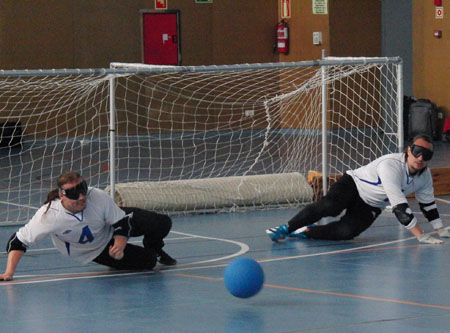World Goalball Championship from June 26 through July 8, 2014 in Finland
Intelligent analysis is the key to success

Goalball was developed in 1946 especially for people with a visual impairment. Two teams of three players face each other on a 9 by 18-meter pitch. The aim of the game is to score in your opponent’s goal using the 1.25 kg ball, which is about the same size as a basketball. The ball contains bells to help the players locate it during the game.
“Orientation on the field is a really important part of the offensive play in goalball,” explains Dr. Daniel Link from the TUM Chair of Training Science and Sport Informatics. “When defending, it’s more important to anticipate the ball’s trajectory and to prepare yourself for a number of different attacking formations,” adds Christoph Weber, who is supporting the project as a doctoral candidate and will be looking after the teams in Espoo.
Taking the lead from beach volleyball’s Olympic gold medalists
Link’s team has developed a piece of software that allows the German national goalball team to observe and analyze games. They based their two software modules – GoalScouter and GoalViewer – on a similar tool used in beach volleyball. “Julius Brink and Jonas Reckermann used this tool to optimize their tactics at the 2012 Olympics and it helped them bring home a gold medal,” explains Link.
During the game, a trainer or assistant commentates the game live on a tablet. They can add valuable information on the state of play, including player position, throwing technique or the result of an attack (goal, no goal, penalty). Modern image recognition capabilities allow a lot of information to be transmitted automatically to the tool, e.g. ball velocity. This builds a database, which can then be used to evaluate a team’s own tactics – or those of their opponents. Based on this analysis, teams can adapt their offensive and defensive strategy, improving their overall performance.
On track for success at Espoo
The German national goalball team has been working with the GoalScouter monitoring tool since the 2012 Paralympic Games, and they started using the GoalViewer analysis and visualization tool for the 2013 European Championship. The national team trainer uses both applications to build intelligence on their opponents – the perfect way to prepare for the World Championship.
“We want to do really well at the Goalball World Championship,” says Thomas Prokein, trainer of the German women’s team. “With TUM’s special methodology and software, we have gathered a lot of valuable insights. For example, we have mapped how each of our opponents takes a penalty – giving us a better chance of stopping them.”
The men’s national team has already seen the benefits of the game analysis tool – they won gold at the Intercup in Sweden (May 28 through June 2, 2014).
The projects have been funded by the Bundesinstitut für Sportwissenschaft (BISp, federal institute of sports science) since 2010 (beach volleyball) and 2012 (goalball).
Contact:
Dr. Daniel Link
Technische Universität München
Chair of Training Science and Sport Informatics (Prof. Dr. Martin Lames)
phone: +49.89.289-24498
daniel.link@tum.de
www.trainingswissenschaft.sp.tum.de